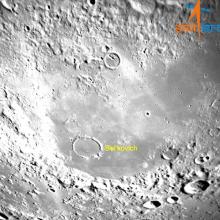Listen to today's episode of StarDate on the web the same day it airs in high-quality streaming audio without any extra ads or announcements. Choose a $8 one-month pass, or listen every day for a year for just $30.
You are here
Moon and Regulus
The Moon is a giant among the more than 200 known moons of the solar system’s major planets. It’s the fifth-largest and -most massive. It’s the second-densest. And it’s the largest compared to its host planet. As a result, some scientists consider Earth and the Moon to be a double planet.
To bolster that picture, the Moon is put together in a similar way to Earth. It has a dense core, made mostly of iron with a smattering of other metals. The core is wrapped in a layer of molten iron. In turn, that layer is wrapped in a partially molten layer of metals and rock. Then there’s a thick mantle of rocky materials, topped by a thin crust.
The crust isn’t the same around the entire Moon, though. On average, it’s about 40 to 45 miles thick on the near side, but about twice as thick on the far side.
That may be a result of the Moon’s relationship with Earth. The same hemisphere of the Moon always faces Earth — the reason we always see the same features. Asteroids and comets are pulled in by Earth’s gravity. As they approach the Moon, they’re more likely to hit the far side. The extra impacts build up a thicker crust — one big difference between the Moon and Earth.
The Moon is in its gibbous phase now, so it’s nice and bright. It stands high in the south at nightfall. And it has a bright companion: Regulus, the star that marks the heart of the lion.
Tomorrow: 18th-century technology in the southern sky.
Script by Damond Benningfield






